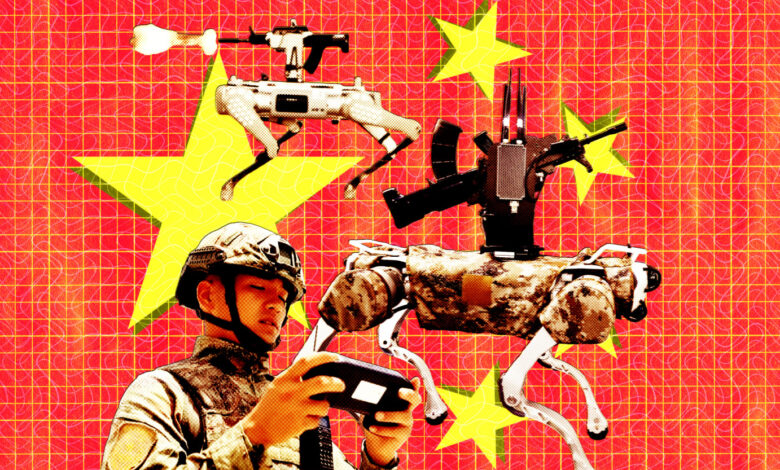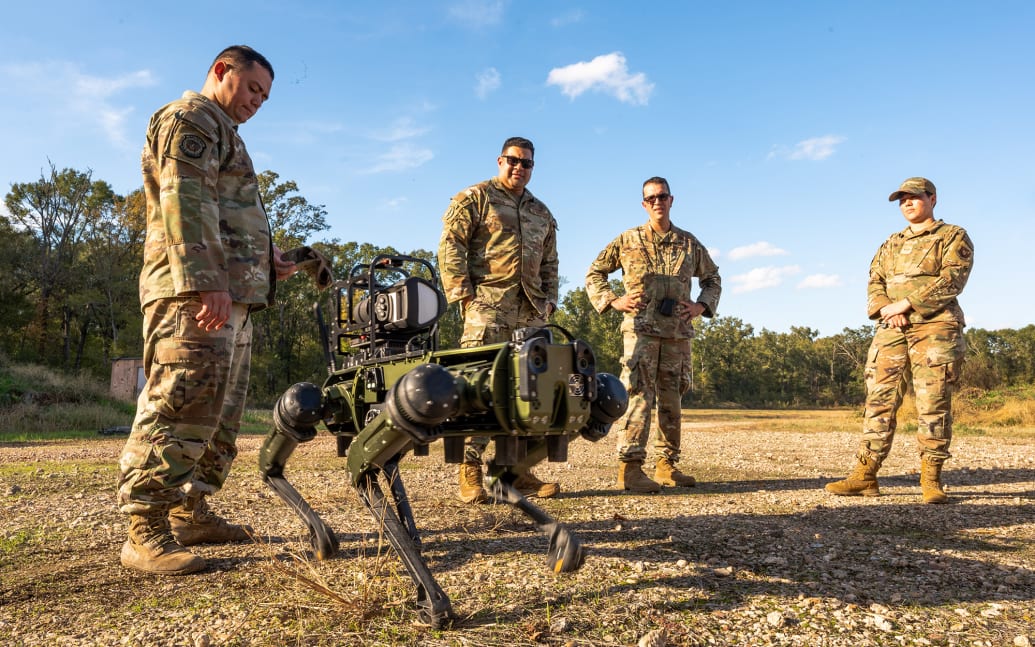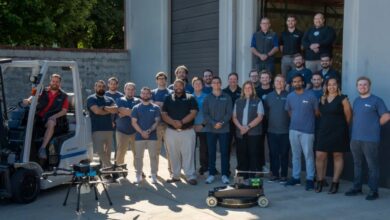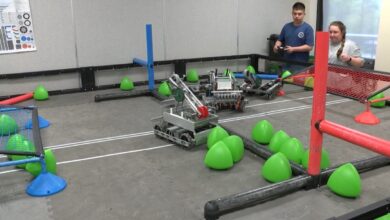Are China’s Big, Bad, Gun-Slinging Robot Dogs the Future of Warfare?

In recent military drills with Cambodia, China unleashed a slew of robotic “dogs” that are equipped with rifles, primed and ready to take on urban combat operations for Beijing. Footage of the menacing machines in action has offered a glimpse into a future where robots can replace manpower in times of war—and stirred debate about what the United States could be up against in a conflict with China.
“It can serve as a new member in our urban combat operations, replacing our members to conduct reconnaissance and identify [the] enemy and strike the target,” a Chinese soldier, named Chen Wei, said of the newest member of the Chinese military, according to state broadcaster CCTV.
“During our missions, it can provide real-time transmission of reconnaissance footage to the command posts,” another soldier, Yang Shengzhi, said.
In the drills, known as China and Cambodia’s Golden Dragon 2024 exercise, the dog is shown jumping, walking, and leaning in different directions. It is filmed squatting, moving backward, and firing a gun. It can even plan its own routes and avoid obstacles, according to CCTV.
China is not alone in its interest in using robots in warfare, and it’s certainly not first to the game: The U.S. has been experimenting with robotic warfare for decades.
The American military first used robots as a tool for combat in the war in Afghanistan. In 2002, for instance, four robots named “Hermes,” “Professor,” “Thing,” and “Fester” would enter buildings before troops in order to scope out the environment and prevent U.S. casualties. Even then, those robots were able to hold a grenade launcher and a 12-gauge shotgun, in addition to 12 cameras. In Iraq, thousands of robots were used on the battlefield.
The Chinese and Cambodian military attend a demo of robot battle dogs.
Tang Chhin Sothy/AFP via Getty
Since then, the U.S. military has been expanding on the concept. Examples of unmanned aircraft systems (drones) abound and have already changed how wars are fought, including the conflict in Ukraine. The U.S. Navy has been working with unmanned and autonomous vessels as well; earlier this year, the U.S. military ran an exercise to buttress its understanding of how humans and robots and machines work together on the battlefield.
Despite the shock value of the videos from China, its attempt at mounting a gun to its robot is not necessarily that impressive compared to the U.S., according to Benjamin Jensen, senior fellow for future war, gaming, and strategy at the Center for Strategic and International Studies.
“If that’s what they really want to showcase, we shouldn’t be too concerned,” Jensen told The Daily Beast. “It’s a basic assault rifle, pretty crudely from the look of it, attached to a knockoff robotic dog,” he added, referring to how the Chinese government’s robot dog sure looks a lot like Boston Dynamics’ robotic dogs, whose capabilities have been showcased publicly for years in the United States.
“It’s like the worst of the worst knockoffs,” said Jensen, who is also a professor of strategic studies at the Marine Corps University’s School of Advanced Warfighting.
There are benefits to using robots in warfare, and the bet China appears to be making is that using a robot or an autonomous machine to conduct some operations could free up manpower for other operations and reduce human casualties in conflict.
But China, or any other military, for that matter, likely won’t have an entirely robotic People’s Liberation Army (PLA), warned Jensen.
“How does this make it… more or less effective than if you just had a PLA soldier with an assault rifle? In one sense [it’s] more effective in that it’s not afraid and you can maneuver it into position over rugged terrain to lay down a base of fire,” he said. “But in a lot of senses, it’s less effective in that who does the spot checks… who basically does ‘SPORTS’—an acronym for when your weapon jams—who cleans the barrel? So it might look like it’s replacing people, but it’s just changing the role of the person in relation to combat.”
Humans will still likely be operating behind the scenes to coordinate at the tactical level.
“This isn’t Terminator and this isn’t full autonomy, this is just an extension of a human’s ability to use violence in pursuit of political objectives,” Jensen said.
China has traditionally struggled with using robots over complicated terrain, according to Christian Curriden, a defense analyst at RAND who focuses on China’s PLA research and development as well as artificial intelligence applications in the PLA. And that’s where the rubber will meet the road for robotics in broader military applications.
“It’s one thing to be able to build a robot that… can cross rugged terrain, whether you use a dog form or whether you use just a traditional kind of like remote control car platform. It’s a whole other thing to be able to add a weapon to it and stabilize that weapon as it fires, and it’s a whole new level of complexity to integrate that into a battle network,” Jensen added.
In a matchup between Chinese and American robotic capabilities, China may be better prepared to deploy robots en masse with quick uptake, warned Jensen. But the U.S. may win out when it comes to innovation.
“If it’s about mass use and possibility of mass adoption in a short amount of time, I think China, the People’s Liberation Army, has a leg up,” Jensen said. “But if… it’s exquisite and novel creations, I think the U.S. is still head and shoulders the best.”
Robot Races
In the United States, Army brass has sought to remove the need for humans to make first contact with enemies in conflict.
“We will never again trade blood for first contact,” Gen. James Rainey, the commanding general of Army Futures Command, told Defense News earlier this year.

A team from the 2nd Civil Engineer Squadron monitors Atom a robot dog while remote controlling it on Nov. 6, 2023, at Barksdale Air Force Base, Louisiana.
Senior Airman William Pugh/USAF
The Department of Defense’s so-called “Replicator Initiative,” headed up by the Defense Innovation Unit (DIU), is focused on fielding thousands of uncrewed vehicles between March and August of next year, in order to deploy unmanned systems en masse.
And the program is aimed at countering China in particular, top U.S. officials say.
“Replicator is meant to help us overcome the PRC’s biggest advantage, which is mass. More ships. More missiles. More people,” Deputy Secretary Kathleen Hicks said in remarks on the program last year. “But historically, even when we mobilized our economy and manufacturing base, rarely have America’s war-winning strategies relied solely on matching an adversary ship-for-ship and shot-for-shot. After all, we don’t use our people as cannon fodder like some competitors do. Instead, we out-match adversaries by out-thinking, out-strategizing, and out-maneuvering them.”
Although top military officials have been broadcasting that they were working on the operation, the project is cloaked in secrecy. The Pentagon for months refused to outline specific capabilities or systems to protect the program from prying eyes.
Just this May, Hicks gave a little teaser and revealed the first tranche of capabilities: uncrewed surface vehicles (USV), uncrewed aerial systems (UAS) and counter-uncrewed aerial systems (c-UAS).
The military in particular is focusing its aerial work with AeroVironment Inc., whose Switchblade drones have helped Ukraine thwart Russia’s invasion. The Pentagon is also set to ink several deals in the maritime domain this summer, Hicks said.
Other maritime and counter-uncrewed aerial systems (c-UAS) plans remain classified.
The Pentagon has plans to spend about $1 billion on the program between fiscal years 2024 and 2025.
The new, mysterious project will get more autonomous systems in the line of fire and reduce the number of U.S. casualties in confrontations with adversaries like China. The hope is that the U.S. military can more easily and quickly update them, than, say, a tank. Clunky, outdated, and expensive war fighting is out—nimble, updatable, and cheap is in.
“We must ensure the PRC leadership wakes up every day, considers the risks of aggression, and concludes, ‘Today is not the day’—and not just today, but every day, between now and 2027, now and 2035, now and 2049, and beyond,” Hicks said.
Speculation has been swirling that the program is aimed at building out systems that can “swarm” on the battlefield—but as the U.S. military continues to contemplate and build out its robotic future, thorny decisions about unmanned and autonomous warfare operations loom large.
For one, the Pentagon’s acquisition system may lag behind the vision for the Replicator future envisioned by DIU, as it might not be capable of acting on the same timeline Replicator leaders have laid out, a military analyst, Bill Greenwalt, told lawmakers on Capitol Hill in the fall.
Ethical questions loom large over the use of robots in war as well. Boston Dynamics, along with several other robotics companies, signed a pledge years ago that they will not weaponize their advanced robots.
Cybersecurity questions abound for militaries with unmanned, uncrewed, and robotic systems in times of crisis. Would-be hackers and adversaries can exploit robots on the battlefield, where the machines can be vulnerable to man-in-the-middle attacks, data breaches, or any other number of cyberattacks against robots’ sensors or communications.
And in a matchup in China’s backyard, Replicator might not stack up given the ranges needed to operate in the Indo-Pacific region, according to a report from the the Congressional Research Service (CRS).
But time is running out to leap ahead of competitors and adversaries, warned Gen. Mark Milley, who recently retired as chairman of the Joint Chiefs of Staff, the nation’s highest-ranking military officer.
“Geostrategic competition and rapidly advancing technology are driving fundamental changes to the character of war. Our opportunity to ensure that we maintain an enduring competitive advantage is fleeting,” Milley wrote in a report in the fall. “Our window of opportunity to ensure that we maintain an enduring competitive advantage is closing.”



